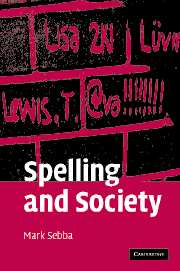Book contents
- Frontmatter
- Contents
- Illustrations
- Maps
- Diagrams
- Tables
- Acknowledgements
- Note on transcription
- 1 Map showing location of languages in Europe mentioned in this book
- 2 Map showing location of languages outside Europe mentioned in this book
- Introduction: society and orthography
- 1 Approaching orthography
- 2 Orthography as social practice
- 3 Language contact, linguists and the emergence of orthographies
- 4 ‘Postcolonial’ Orthographies
- 5 Between language and dialect: orthography in unstandardised and standardising vernaculars
- 6 Reform or revolution: where angels fear to tread
- 7 Why do we spell?
- Glossary
- References
- General index
- Index of language names
- Index of surnames
5 - Between language and dialect: orthography in unstandardised and standardising vernaculars
Published online by Cambridge University Press: 22 September 2009
- Frontmatter
- Contents
- Illustrations
- Maps
- Diagrams
- Tables
- Acknowledgements
- Note on transcription
- 1 Map showing location of languages in Europe mentioned in this book
- 2 Map showing location of languages outside Europe mentioned in this book
- Introduction: society and orthography
- 1 Approaching orthography
- 2 Orthography as social practice
- 3 Language contact, linguists and the emergence of orthographies
- 4 ‘Postcolonial’ Orthographies
- 5 Between language and dialect: orthography in unstandardised and standardising vernaculars
- 6 Reform or revolution: where angels fear to tread
- 7 Why do we spell?
- Glossary
- References
- General index
- Index of language names
- Index of surnames
Summary
Introduction
So far in this book we have looked mainly at two kinds of languages: languages which already had established orthographies, and languages where new orthographies were being developed as part of a planned, or partially planned, process of standardisation.
There is certainly an important link between writing and language standardisation (see e.g. Milroy and Milroy 1991 and Joseph 1987), but a language does not have to be standardised before it can be written. There are many contemporary examples of writing in unstandardised language varieties, and many historical examples of writing vernaculars and ‘dialects’, some of which have later become standard languages.
However, the writing of language varieties which do not have, or do not yet have, a standard presents particular orthographic problems. In this chapter we will look at some of these problems from a social and cultural perspective. For our purposes, such varieties will be taken to include the following:
vernaculars, in the conventional sense of ‘dialects’ of an identified standard language;
contact varieties and intermediate varieties which are characteristic of situations where creole languages are in contact with their (standard) lexifier languages, for example Jamaican Creole (Patois) in Jamaica and in Britain;
other situations where closely related language varieties exist with a continuum between them, for example in Galicia (Spain) where Galician can potentially be viewed as a variety of Portuguese or as a separate language, and is also close to Spanish.
- Type
- Chapter
- Information
- Spelling and SocietyThe Culture and Politics of Orthography around the World, pp. 102 - 131Publisher: Cambridge University PressPrint publication year: 2007



